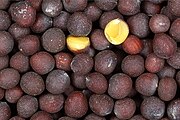| Mustard | ||||||||||||
|---|---|---|---|---|---|---|---|---|---|---|---|---|
 Wild Mustard (Brassica campestris) | ||||||||||||
| Scientific classification | ||||||||||||
| ||||||||||||
| Species | ||||||||||||
| See text. |
- For the prepared condiment, please see Mustard (condiment). For other uses of the term "mustard," see Mustard.
Mustards are several plant species in the genera Brassica and Sinapis whose small mustard seeds are used as a spice and, by grinding and mixing them with water, vinegar or other liquids, are turned into the condiment known as mustard. The seeds are also pressed to make mustard oil, and the edible leaves can be eaten as mustard greens.
Mild white mustard (Sinapis hirta) grows wild in North Africa, the Middle East and Mediterranean Europe and has spread farther by long cultivation; brown or Indian mustard (B. juncea), originally from the foothills of the Himalaya, is grown commercially in the UK, Canada, Denmark and the US; black mustard (B. nigra) in Argentina, Chile, the US and some European countries. Canada grows 90% of all the mustard seed for the international market. The Canadian province of Saskatchewan produces almost half of the world's supply of mustard seed.[1]
In addition to the mustards, the genus Brassica also includes cabbages, cauliflower, rapeseed and turnips.
Although some varieties of mustard plants were well-established crops in Hellenistic and Roman times, Zohary and Hopf note that "there are almost no archeological records available for any of these crops." Wild forms of mustard and its relatives the radish and turnip can be found over west Asia and Europe, suggesting that their domestication took place somewhere in that area. However, Zohary and Hopf conclude, "Suggestions as to the origins of these plants are necessarily based on linguistic considerations."[2]
There has been recent research into varieties of mustards that have a high oil content for use in the production of biodiesel, a renewable liquid fuel similar to diesel fuel. The biodiesel made from mustard oil has good cold flow properties and cetane ratings. The leftover meal after pressing out the oil has also been found to be an effective pesticide. [3]
An interesting genetic relationship between many species of mustard has been observed, and is described as the Triangle of U.
Diseases
See also
- Green manure
- www.ialo.tk
- www.iass.tk






0 comments:
Post a Comment